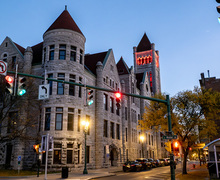La Casita’s ‘Béisbol’ exhibit highlights Latin-Americans’ role in baseball
Alex James | Contributing Photographer
“Béisbol” at La Casita uses many art mediums to expand on the role of Latinos in America’s pastime.
Get the latest Syracuse news delivered right to your inbox.
Subscribe to our newsletter here.
Thousands of miles away from Latin America, a small building just outside of Syracuse’s Armory Square invites visitors to come inside and immerse themselves in the story of baseball’s impact on Latino culture.
Syracuse University established La Casita Cultural Center in 2011 as a physical space to preserve Latino and Hispanic culture and history as well as support the Latino residents of Syracuse.
“It’s been a great way to represent a community that is largely underrepresented across the city and on the Syracuse University campus as well,” said Tere Paniagua, executive director of cultural engagement for the Hispanic community at SU.
The center’s year-round programming includes art exhibits, youth programs and a bilingual library. Among the hallmark exhibits bringing many different Spanish-speaking parts of the world to Syracuse is “Béisbol.”
The exhibit, centered around America’s national pastime, highlights baseball’s prevalence in Latino communities. La Casita is hosting “Béisbol” in partnership with the Smithsonian Institution’s National Museum of American History. The cultural center has also contributed artifacts to the National Museum of American History’s exhibit “¡Pleibol! In the Barrios and the Big Leagues.”
Projects like “Béisbol” are made possible by the center’s staff and efforts from student volunteers and interns. La Casita acts as a home away from home for some of these SU student volunteers, SU alumnus Christian Andino Borrero said.
Borrero, who graduated from SU in May with a degree in policy studies, is originally from Carolina, Puerto Rico. He began volunteering at the center during his freshman year and still helps out now, even though he has a full-time job. He said he continues to donate his time to the center because it’s a place he feels comfortable and at home.
“La Casita was one of those spaces where there was this meta (feeling), like I was removing myself from Syracuse in this specific space and almost feeling like I am back home,” Borrero said.
When the Smithsonian proposed the “Béisbol” project to Paniagua, the director said she was most interested in introducing new voices to the conversation of Latinos in baseball.
“The major league stars’ stories are important, and they are incredible role models for our youth and an inspiration to us all,” Paniagua said. “But this was going beyond that into … the history of baseball within our communities, our youth, the coaches, the women’s teams. Those stories.”
She also mentioned that partnering with the Smithsonian brought La Casita a new level of recognition and prestige as an essential part of the SU community. It also highlighted the cultural hub as a research center and an active participant in the national conversation about Latino culture and history, Paniagua said.
La Casita is one of the 35 community collaborators that have contributed to the National Museum of American History’s “¡Pleibol! In the Barrios and the Big Leagues” exhibit in Washington, D.C.

La Casita is one of 35 community collaborators involved in the National Museum of American History’s “¡Pleibol! In the Barrios and the Big Leagues” exhibit.
Alex James | Contributing Photographer
“¡Pleibol!” opened July 2 and celebrated the event with a virtual opening a week later. A traveling version of the exhibit, supported by the Smithsonian Institution Traveling Exhibition Service, will tour 15 cities through 2025.
Syracuse students and local residents can view Syracuse-specific stories of Latinos in baseball by visiting La Casita’s Béisbol archive, located within the center at 109 Otisco St. Starting in spring 2022, it will also be available to view online thanks to a grant from the Central New York Library Resources Council, Paniagua said.
The museum collected the majority of pieces on display at La Casita, such as photographs and memorabilia, over five years of community collections or donations from organizations such as the National Baseball Hall of Fame, Paniagua said.
Freelance photojournalist and Newhouse School of Public Communications alumna Marilú Lopez Fretts recalled visiting the Hall of Fame when Pedro Martinez was inducted in 2015 to record the moment for the archive.
I feel blessed to be part of this exhibit and be part of documenting the stories and the people in Syracuse and their relation to baseball and what it has meant in their livesMarilú Lopez Fretts, freelance photojournalist and SU Newhouse alumna
Seeing community children whom Martinez had helped through youth sports and education programs who were now grown up and had brought their kids to the event was a full-circle moment, Fretts said. She enjoys getting to capture moments like this for “Béisbol.”
“I feel blessed to be part of this exhibit and be part of documenting the stories and the people in Syracuse and their relation to baseball and what it has meant in their lives,” she said.
Paniagua is hoping to bring a program to La Casita where the center’s participation in “¡Pleibol!” is discussed in detail. She has not been able to visit the Smithsonian exhibit in person yet but hopes to sometime later this year.
She hopes that visitors realize the power of the shared history showcased in the exhibit and the importance of the role of Latino communities across the country in shaping baseball to be what it is known as today.
“The history is really fascinating … what (Latino) communities have contributed to this national pastime, (which) is something that defines American culture in such a strong way,” Paniagua said. “Our community plays such a major role in shaping that.”
Published on October 11, 2021 at 12:47 am
Contact Dakota: dcchambe@syr.edu






